Effects of Residual Stresses on Strength and Crack Resistance in ZrO2 Ceramics with Alumina Coating
2022-06-29LIHaiyanHAOHongjianTIANYuanWANGChanganBAOYiwangWANDetian
LI Haiyan,HAO Hongjian,TIAN Yuan,WANG Changan,BAO Yiwang,WAN Detian
(1.China Building Material Test &Certification Group Co.,Ltd,Beijing 100024,China;2.State Key Laboratory of Green Building Materials,China Building Materials Academy,Beijing 100024,China;3.State Key Laboratory of New Ceramics and Fine Processing,School of Materials Science and Engineering,Tsinghua University,Beijing 100084,China)
Abstract: By covering a thin Al2O3 coating on ZrO2 substrate,compressive stress caused by the mismatch of thermal expansion coefficients between the coating and substrate was introduced in the surface layer of Al2O3-ZrO2 pre-stressed ceramics (marked as ACZS pre-stressed ceramics).Vickers indentation test was carried out to check the crack resistance in the surface layer and substrate influenced by the residual stresses.The enhancement of the crack resistance in surface layer results in a high flexural strength and excellent damage tolerance.Both theoretical analysis and experimental results show that the compressive stress and crack resistance in the surface layer increase with the increasing ratio of the cross-sectional area of ZrO2 substrate to Al2O3 coating.Due to the residual compressive stress existing in Al2O3 coating,a high flexural strength of (1207±20) MPa was measured for ZrO2 specimens coated with 40 μm Al2O3.The flexural strength is 32% higher than that of monolithic ZrO2,and about triple of the value of Al2O3.Meanwhile,compared to ZrO2,the ACZS pre-stressed ceramics exhibit superior thermal shock resistance.
Key words: Al2O3-ZrO2 pre-stressed ceramics;compressive stress;flexural strength;damage tolerance
Zirconia (ZrO2) materials have been widely applied in fuel cell,refractory materials,and construction materials due to the prominent mechanical and chemical properties such as high hardness,strength,good wear-resistant,fine oxygen ionic conductivity,excellent heat-insulating and corrosion protective[1-3].With the rapid advances of engineering applications,ceramic materials with higher strength and reliability are greatly needed.Therefore,significant improvements are essential to fabricate zirconia components with higher strength and excellent damage tolerance to improve the lifetime and safety of ceramic components.Many efforts including reinforcement strengthening (such as the incorporation of fibers,particles,and whiskers)and transformation toughening were applied to improve the strength and toughness of ZrO2[4-6].Among them,the way to enhance the strength and damage tolerance of brittle ceramics by introducing residual compressive stress in the surface layer was more attractive because of its remarkable strengthening effect and convenience[7-8].It is well-known that the fracture of ceramics is mainly caused by crack propagation in the surface layer.Thus,the key to improve the strength and damage tolerance of ceramics is to enhance the resistance to crack propagation in the surface[9].By covering a coating with lower coefficient of thermal expansion (CTE) than the substrate,compressive stress generated in the coating layer after sintering.Then the compressive stress hinders the crack extension,thereby improve the strength and damage tolerance of ceramics.
In order to illuminate the strengthening mechanism,it is important to understand the effect of residual stress on crack propagation.As it is well known that indentation deformation strongly links to the crack initiation and crack propagation.For the crack propagation behavior investigation,Vickers indentation proposed by Palmquvist in the late 1950s has been widely used because of its simplicity and efficiency[10].By comparing the growth of crack from the indentations made in unstressed and stressed materials,the effect of residual stress on crack propagation could be studied.
In this work,hot-pressed sintering (HP) was used to fabricate ZrO2ceramics covered by Al2O3coating with strong interface bonding and high density.For comparison,monolithic ZrO2ceramics were also prepared by the HP process using the same technical parameters.The effects of different ratios of cross-sectional area of substrate to coating (marked asSs/Sc) on residual stresses and the crack resistance were further investigated.
1 Experimental
1.1 Material synthesis
Commercial zirconia with an average particle size ofD50=220 nm (3% Y2O3(molar percent),G3Y-020OO,Shangdong Sinocera Functional Materials Co.Ltd.,China)and alumina with an average particle size ofD50=220 nm(SAO-020A-M,Shangdong Sinocera Functional Materials Co.Ltd.,China) were used as the raw materials in this research.Alumina powders,deionized water,and dispersant (Isobam104 with a molecular weight of 55000-60000,provided by Kuraray Co.,Ltd.,Osaka,Japan)were added to produce alumina slurry,and their mass contents were 30%,69.2%,and 0.8%,respectively.The mixture was obtained using a planetary mill (YXQM-1L,MITR,China) for 24 h in zirconia containers with the ball-to-powder weight ratio of 10:1 and rotational speed of 150 r/min.
To fabricate the ACZSpre-stressed ceramics by hotpressed sintering,graphite die with a diameter of 50 mm was uniformly sprayed with the above alumina slurry.And the thickness of the Al2O3coating was about 40 μm.Then zirconia powder was put into the Al2O3-coated graphite die followed by applying a constant pressure of 10 MPa.The specimens were heated up to 1450 ℃ at a heating rate of 15 ℃/min,and then a constant pressure of 30 MPa was applied for 60 min.For comparison,a monolithic ZrO2specimen was prepared by a hot-pressing sintering at 1450 ℃ with the pressure of 30 MPa for 60 min.Both the ZrO2specimens with a dimension of 3 mm×4 mm×36 mm and the ACZSpre-stressed ceramics with the size of 3.6 mm×4 mm×36 mm were machined(the original thickness of ACZSpre-stressed ceramics prepared by hot-pressed sintering was 3.6 mm).
1.2 Characterization
Morphology of the specimens was observed by using a scanning electron microscope (SEM) (Merlin,Zeiss,Germany).The flexural strength was measured by the three-point bending tests with a span length of 30 mm and a crosshead speed of 0.5 mm/min (according to ISO 14704:2000).The residual strengths were investigated to evaluate the thermal shock resistance after quenching the specimens from different temperatures (200,250,300,350,400 ℃) to 20 ℃ water (according to ASTM C1525-18).The measured value of strength is the average of 5 separate measurements.In order to study the effect of residual stress on crack propagation behavior,the specimens with Al2O3coatings of different thicknesses(40,30,20 μm) were used,because the residual stresses change with the coating thickness.The Vickers indenter(Tukon2500B,Wilson,America) was used to generate the indentation and indentation cracks under different loadings.
2 Results and discussion
The ACZSpre-stressed ceramics were designed as the schematic diagram for plates in Fig.1(a).To generate compressive stresses in the surface layer,Al2O3was applied as the coating material,because it has a lower coefficient of thermal expansion (CTE) than ZrO2.Due to CTE difference between Al2O3coating and ZrO2substrate,residual compressive stress was generated in the Al2O3coating during the cooling process of the ACZSpre-stressed ceramics.The way to fabricate pre-stressed ceramics is also available for any ceramic components of various shapes,including cylinders,tubes and spheres,as illustrated in Fig.1(a).As for structural ceramics,the interface bonding generates significant impacts on mechanical properties[11].Fine interface bonding manner was investigated from the continuous and tight interface illustrated in Fig.1(b).The cross-sectional SEM image of the ACZSpre-stressed ceramics indicates that the thickness of Al2O3coating is near 40 μm (while the thickness for ZrO2substrate is 3.6 mm).Therefore,by employing HP sintering,ACZSpre-stressed ceramics with a good interface bond between Al2O3coating and ZrO2substrate can be successfully fabricated.
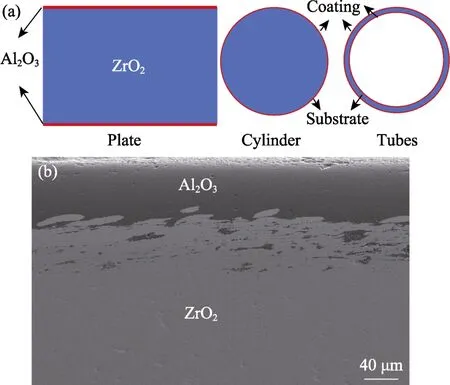
Fig.1 (a) Schematic diagram of the ACZS pre-stressed ceramics;(b) SEM image of interface between ZrO2 substrate and Al2O3 coating
To investigate the effect of residual stress on crack propagation behavior,Vickers indentation tests were carried out on the ZrO2ceramics and the ACZSpre-stressed ceramics with different ratios of sectional area (Ss/Scis the ratio of substrate to coating in the schematic diagram of plates shown in Fig.1(a)).By comparing the length and expanded direction of crack in Fig.2(b) and Fig.3,the indentation diagonal half-lengthaand the crack lengthc(illustrated in Fig.2(a)) can be easily obtained through the observation of indentation morphology.On this basis,the indentation fracture resistance (KI,IFR) used to describe the resistance to indentation cracking[12]can be calculated by Eq.(1)[13].Since the residual stresses are distributed anisotropically,the test conditions for determine the crack resistance does not satisfy all the application requirements of Eq.(1) mentioned in ISO 14627.It is effective to evaluate the crack resistance at different directions in the surface layer and substrate by comparing the measured values ofKI,IFR.
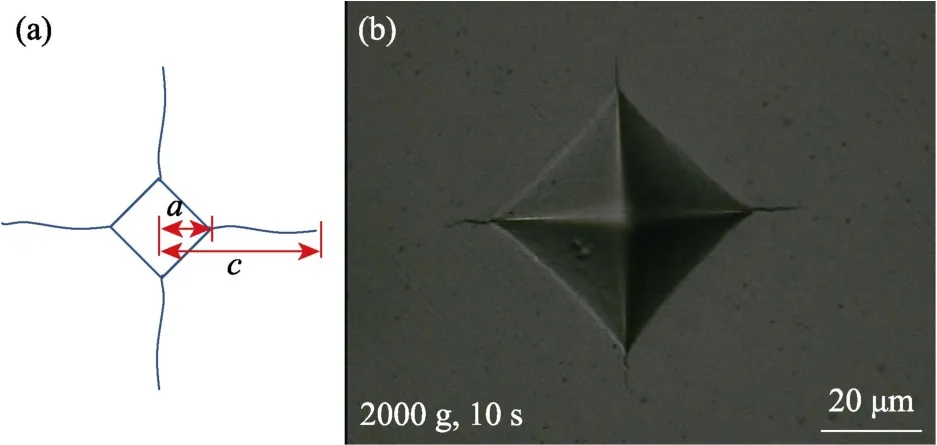
Fig.2 (a) Typical Vickers indentation of ZrO2 ceramics;(b) Optical photograph of the indentation morphology for ZrO2 ceramics without residual stress
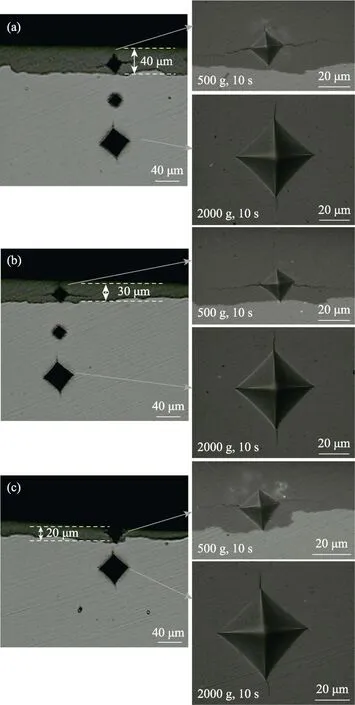
Fig.3 Optical photographs of the indentation morphologies for ACZS pre-stressed ceramics with different ratios of the cross-sectional areas,showing the effects of the compressive stresses in the coating and tensile stresses in the substrate

Where,KI,IFR: the indentation fracture resistance value(MPa·m1/2);E: modulus of elasticity (GPa);HV: Vickers hardness (GPa);

P: pressing in load (N);c: half of average of crack length(mm);a: half of average of diagonal line length of indentation (mm).
As for the indentation on the polished surface of ZrO2shown in Fig.2(b),the cracks propagate outward along the diagonal direction.According to Eq.(1),the calculatedKI,IFRof ZrO2ceramics was 9.10 MPa·m1/2(as shown in Table 1).However,different indentation morphology was presented at the ACZSpre-stressed ceramics with different thicknesses of Al2O3coating in Fig.3.As shown in Fig.3(a-c),the crack in Al2O3coating layer propagates along the direction parallel to the interface,while the crack in ZrO2substrate propagates along the direction perpendicular to the interface.The above phenomenon might be attributed to the compressive stress existed in the Al2O3coating,while the tensile stress existed in the ZrO2substrate,as shown in Fig.4.And it is well known that the compressive stresses could restrain crack extension and the tensile stress could promote crack initiation and growth[7-8].Therefore,the cracks perpendicular to the interface were restrained in Al2O3coating layer,while those were promoted in ZrO2substrates.Moreover,it was found that the length of crack in Al2O3surface layer decreases with the increased value ofSs/Sc.The measuredKI,IFRof Al2O3coatings and ZrO2substrates vary with the coating thickness,as shown in Table 1.The result suggests that the variations in the length of crack is the consequences of varied residual stress in the ACZSpre-stressed ceramics with different values ofSs/Sc.Combined Eqs.(3) and (4),the residual stress in the Al2O3coatings and ZrO2substrates could be calculated.

Table 1 Parameters used in formulas and the results of the experiment and simulation

Fig.4 Stress state and Vickers indentation of ACZS pre-stressed ceramics

In any cross-section of the sample,the tensile stresses in the substrate and the compressive stresses in the coating should keep balance,

whereSs,Es,αsare the values of the cross-section areas,elastic modulus and CTE of the substrate,Sc,Ecandαcare those of the coating,respectively.ΔT,the temperature difference,in this test: ΔT=Tsintering-Troom=1425 ℃.
Depending on the calculations,the values of residual stress in the coatings (σc) and substrates (σs) were plotted in Fig.5.As is shown,σcincreased while σsdecreased with the value ofSs/Scincreasing.It can be deduced that,with the value ofSs/Scincreasing,the compressive stress in Al2O3coatings increased,while the tensile stress in ZrO2substrates presented opposite tendency.As compressive stresses could restrain crack extension and the tensile stress could promote crack initiation and growth,the crack resistance of ACZSpre-stressed ceramics was enhanced as the value ofSs/Scincreasing.This is consistent with the crack propagation behavior shown in Fig.2(b) and Fig.3.
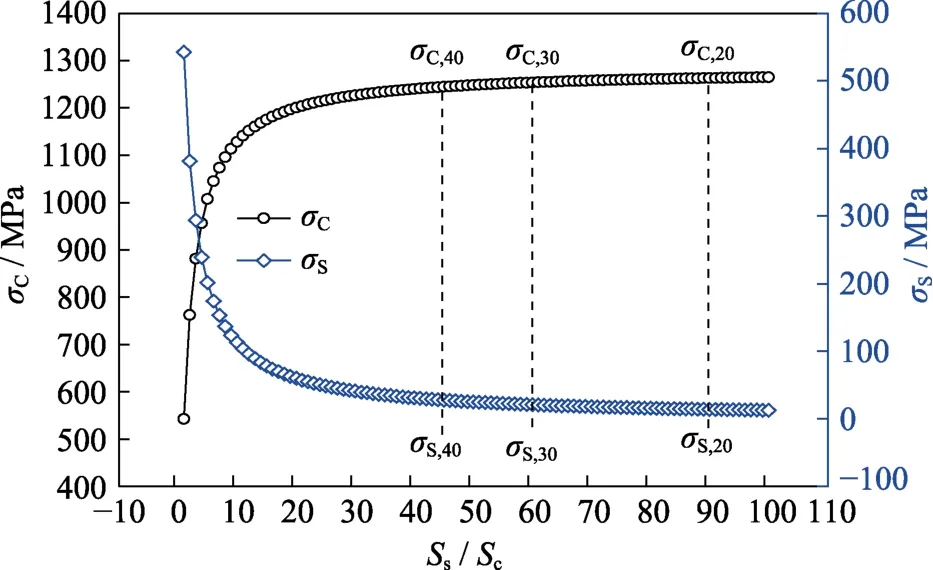
Fig.5 Calculated residual stress in the Al2O3 coating and ZrO2 substrate of ACZS pre-stressed ceramics,as the function of the ratio of cross-sectional area of ZrO2 substrate to Al2O3 coating
Fractographic features of ZrO2ceramics with and without Al2O3coating (40 μm thick) were observed through SEM after bending tests.As shown in Fig.6(a,c),the fracture morphology is smooth without ductile ridge marks.This means that the fracture mode of both ZrO2ceramics and ACZSpre-stressed ceramics is brittle fracture.Grain sizes of uncoated ZrO2ceramic and ZrO2substrate of ACZSpre-stressed ceramics displayed in Fig.6(b,d) are in the range of 400 to 600 nm.Moreover,few pores can be found from the microstructure,indicating that the specimens prepared by the hot-pressing sintering method have high density.
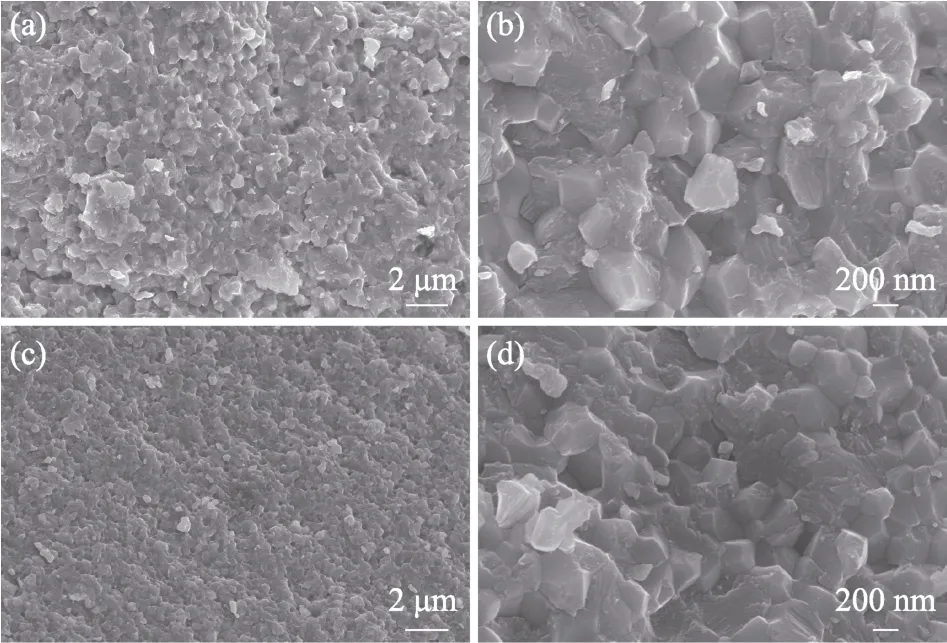
Fig.6 SEM images of the fracture surfaces for monolithic ZrO2 ceramics (a,b) and ZrO2 substrate of ACZS pre-stressed ceramics (c,d) fabricated by the hot-pressing sintering method
The flexure strength of ACZSpre-stressed ceramics with 40 μm thickness of Al2O3coating is (1207±20) MPa,which is 32% higher than that of ZrO2ceramics ((821±15) MPa) fabricated by the same process and about 3-fold of the flexural strength of Al2O3[14].According to the previous reports[15-17],the Al2O3/ZrO2composites fabricated by the conventional methods,such as ZTA or ATZ,or laminated Al2O3/ZrO2,mostly possess a strength with the value between those of Al2O3and ZrO2.Generally,the strength of ceramic composites may be between the reinforcement material and matrix.However,the prestressing design endows the ACZSceramics with a higher strength than Al2O3and ZrO2.The results of the mechanical properties clearly show that the increase in strength is mainly attributed to the residual compressive stress in Al2O3coating,thereby more energy was required for crack extension[18].In addition,the robust interface between substrate and coating material also makes restrictions against crack growth,which has a significant effect on the improvement of the strength and toughness[19].
Another important mechanical property observed for ceramics is the damage tolerance,which represents the ability to inhibit crack extension.The residual strength of two materials was tested after thermal shock with various thermal shock temperatures,as illustrated in Fig.7.The residual strength of both ZrO2and ACZSpre-stressed ceramics with 40 μm thickness Al2O3coating were reduced with the quenching temperature increasing.Especially,the residual strength of ACZSpre-stressed ceramics rapidly dropped from 1040 MPa to 317 MPa when the thermal shock temperature raised from 350 ℃ to 400 ℃,while the residual strength of ZrO2quenched at 350 ℃was only 100 MPa.The result could be ascribed to that the compressive stresses existing in the coating layer can hinder the crack extension.Consequently,it is significant to introduce residual compressive stress in the surface layer of ceramic components to prevent crack propagation.
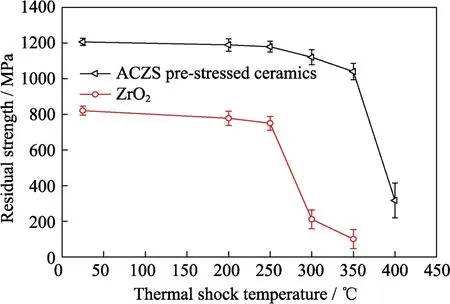
Fig.7 Residual strength of ACZS pre-stressed ceramics and ZrO2 ceramics,after quenching at different thermal shock temperatures
Owing to the high density and residual compressive stresses in the surface layer,ACZSpre-stressed ceramics were endowed with high flexural strength and excellent thermal shock resistance.Moreover,considering the feasibility in economy and simplification in the fabrication,the pre-stressing design to improve mechanical properties has great practical value and prospect in the fields of structural ceramics and domestic ceramics.Besides,unlike the pre-stressed concrete and tempered glass,the pre-stressed ceramics can be machined to specific dimensions,which is more suitable for industrialized production.
3 Conclusions
Pre-stressing design was used to enhance the strength and damage tolerance of ZrO2ceramics by coating a thin Al2O3layer.The magnitude and direction of the residual stress were examined by Vickers indentation tests,and the crack resistance varied with the residual stress was further verified.Experiments indicated that the crack resistance of ACZSpre-stressed ceramics was enhanced with increasing ratio of the cross-sectional area of ZrO2substrate to Al2O3coating.
On account of the residual compressive stress in the coating,the bending strength of ZrO2specimens coated with 40 μm thickness of Al2O3was (1207±20) MPa which is much higher than those of ZrO2(850 MPa) and Al2O3(400 MPa).After quenching from 350 ℃ to water,the residual strength of the ACZSpre-stressed ceramics was measured as 1040 MPa,while the measured residual strength of the ZrO2was only 100 MPa.
杂志排行
无机材料学报的其它文章
- Microstructure and Corrosion Behavior of Brazed Joints of SiC/SiC Composites and Hastelloy N Alloy Using Cu-Ni Alloy
- Reversible Conversion between Space-confined Lead Ions and Perovskite Nanocrystals for Confidential Information Storage
- 微纳米生物活性玻璃诱导牙本质再矿化研究
- 生物活性玻璃-二氧化锰复合支架的制备与表征
- 2D SiC/SiC复合材料电阻率对服役环境的响应特性
- 碳纳米管内填充生长超细一维亚化学计量比氧化钨纳米线
